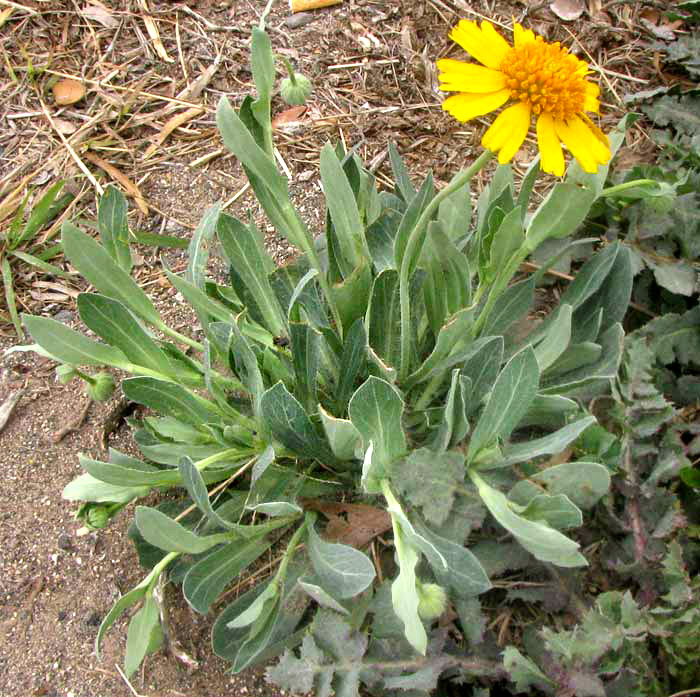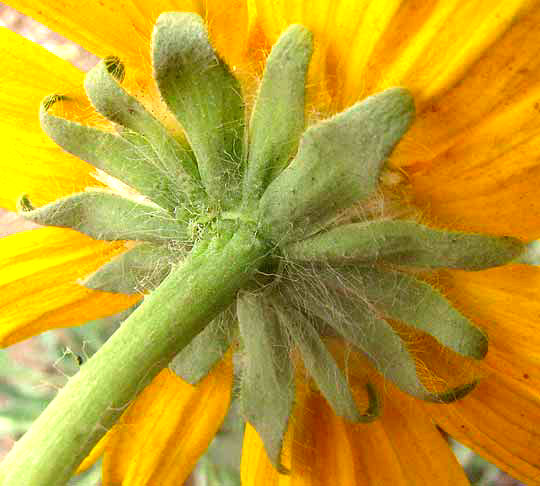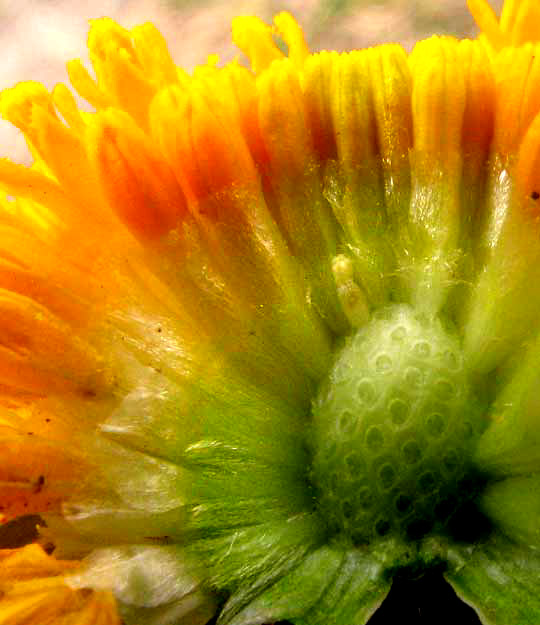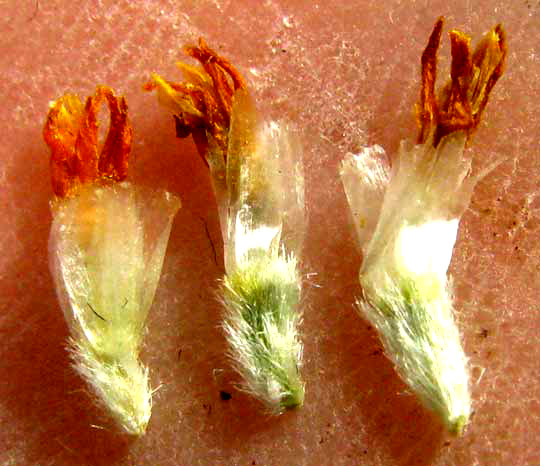Excerpts from Jim Conrad's
Naturalist Newsletter

from the March 9, 2014 Newsletter issued from the Frio Canyon Nature Education Center in the valley of the Dry Frio River in northern Uvalde County, southwestern Texas, on the southern border of the Edwards Plateau; elevation ~1750m (~5750 ft); N29.62°, W99.86°; USA
HUISACHE DAISY
Busy Highway US 90 crosses the country with endpoints in Jacksonville Beach, Florida, three blocks from the Atlantic Ocean, and Van Horn, in arid, far western Texas. In Uvalde it's called Main Street, so when a very unusual looking, ankle-high, daisy-type plant I'd never seen before turned up blossoming brightly not a leg-length from US 90's asphalt, I suspected it might be a weed who'd hitched a ride on a semi-truck from who-knows-where? Above, you can see the plant, its slender, fuzzy leaves clustering at the base and its pretty flowering head about 1½ inches across (4cm).
Notice that several stems arise from the plant's base, each tipped with a flowering head or immature flower buds. Also, the stems do bear a few leaves, so the plant is not one of those daisies whose flowering heads perch atop leafless stems, or peduncles. Also see how deeply cut are the ray flowers' tips.
When noticing field marks to help with identification of plants in this family, the Composite or Daisy Family, the Asteraceae, you always need to see what the involucre looks like below the flowers. This plant's involucral bracts, or phyllaries, bear exceptionally long, soft hairs, and the phyllaries themselves are grouped in an outer and inner series -- which is very different from those of most daisy-type involucres, where the phyllaries are more numerous, are grouped in several series, and overlap one another like roof shingles. You can see this plant's involucre below:

Breaking open the flower head you find a very good field mark, shown below:

The pineapple-like structure bearing the disc flowers is the receptacle and most receptacles of daisy-type plants are much lower, and a few are much higher and more slender. Have one looking like a pineapple really narrows down the identification possibilities. This one reminds me of sneezeweed receptacles, so when I began trying to identify our plant, first I considered possibilities in the "tribe" to which sneezeweeds belong, the Helenieae.
The last picture also shows something funny going on atop the future cypsela-type fruits. In many daisy-type plants white hairs or needle-like spines form the "pappus" atop the cypselas, but this plant's pappus is very different. I kept some disk flowers and the next day when they were dry I could see the situation better, shown below:
 .
.
Instead of hairs or spines, this species' pappus consists of semitransparent, paper-like, square-topped scales. Pappi made of such scales are very unusual, and when I saw them I knew I could identify the plant.
Our plant is the Huisache Daisy, also called Honey Daisy and Butterfly Daisy because its crushed herbage smells a little like honey. It's AMBLYOLEPIS SETIGERA, and it's not a weed that's invaded our area from some distance place on a semi-truck, but rather in the whole world it's native only to south and central Texas, and adjacent northeastern Mexico. Huisache Daisy has so many unusual features that it's the only species in its genus Amblyolepis, and it is indeed closely related to sneezeweeds, genus Helenium.
The name Huisache Daisy comes about because it so often grows among Huisache trees, a species of acacia abundant in the scrub around Uvalde. I read that sometimes the daisy forms an almost solid blanket of gold. The Flora of North America describes its habitat as roadsides and open fields, so along US 90 our plant should feel right at home. It blooms March through May, sporadically through the summer and then again in September through October.